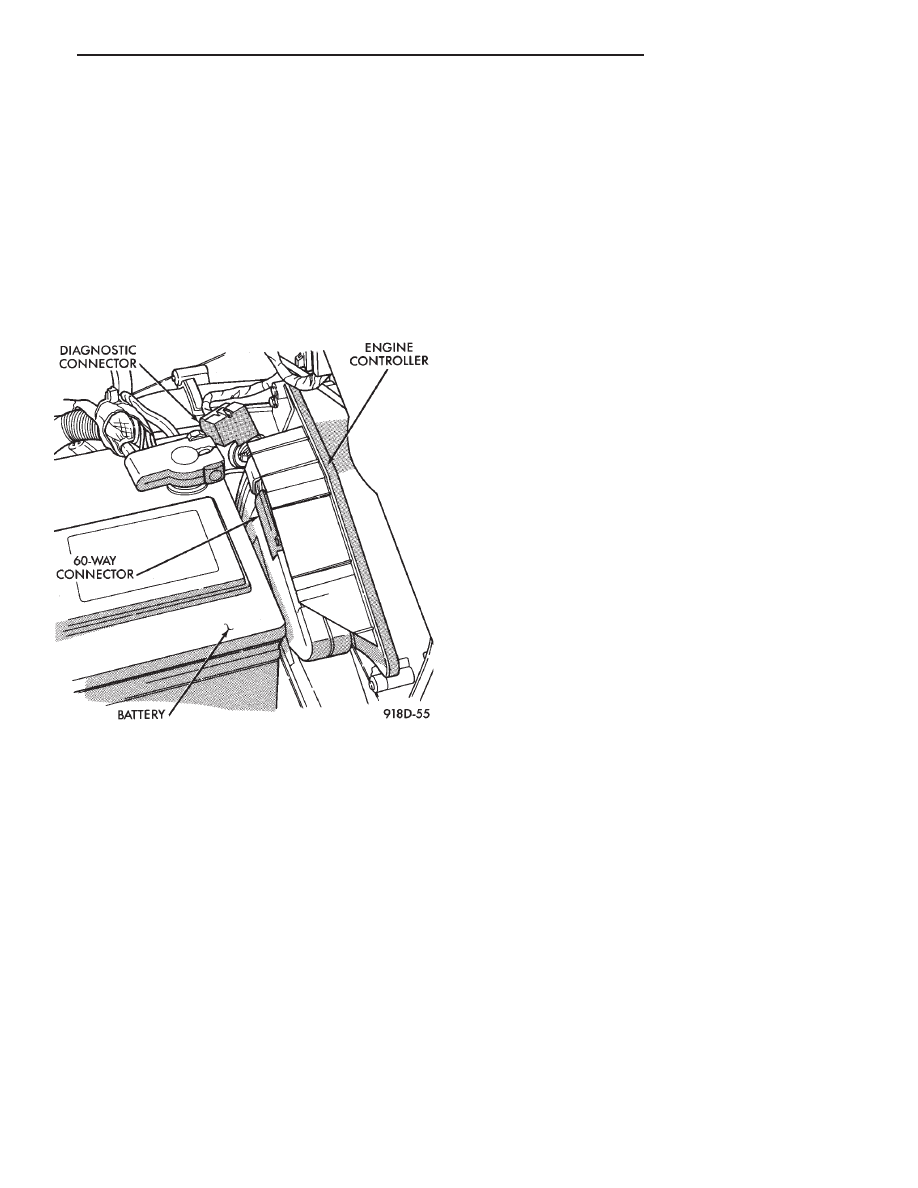Chrysler Town & Country/Voyager, Dodge Caravan, Plymouth Voyager. Manual - part 23

RPM is above 2400 RPM (resulting in a 0 volt input to
the engine controller) a fault code will not be entered
into memory. This is because the condition does not
occur within the specified RPM range.
There are several operating conditions that the en-
gine controller does not monitor and set fault codes for.
Refer to Monitored Circuits and Non-Monitored Cir-
cuits in this section.
Stored fault codes can be displayed either by cycling
the ignition key On - Off - On - Off - On, or through use
of the Diagnostic Readout Box II (DRB II). The DRB II
connects to the diagnostic connector in the vehicle (Fig.
22).
MONITORED CIRCUITS
The engine controller can detect certain fault condi-
tions in the fuel injection system.
Open or Shorted Circuit - The engine controller
can determine if the sensor output (input to controller)
is within proper range. Also, the controller can deter-
mine if the circuit is open or shorted.
Output Device Current Flow - The engine control-
ler senses whether the output devices are hooked up. If
there is a problem with the circuit, the controller
senses whether the circuit is open, shorted to ground,
or shorted high.
Oxygen Sensor - The engine controller can deter-
mine if the oxygen sensor is switching between rich
and lean once the system has entered closed loop. Refer
to Modes of Operation in this section for an explanation
of closed loop operation.
NON-MONITORED CIRCUITS
The engine controller does not monitor the following
circuits, systems and conditions that could have mal-
functions that result in driveability problems. Fault
codes may not be displayed for these conditions. How-
ever, problems with these systems may cause fault
codes to be displayed for other systems. For example, a
fuel pressure problem will not register a fault directly,
but could cause a rich or lean condition. This could
cause an oxygen sensor fault to be stored in the engine
controller.
Fuel Pressure - Fuel pressure is controlled by the
fuel pressure regulator. The engine controller cannot
detect a clogged fuel pump inlet filter, clogged in-line
fuel filter, or a pinched fuel supply or return line.
However, these could result in a rich or lean condition
causing an oxygen sensor fault to be stored in the
engine controller.
Secondary Ignition Circuit - The engine control-
ler cannot detect an inoperative ignition coil, fouled or
worn spark plugs, ignition cross firing, or open spark
plug cables.
Engine Timing - The engine controller cannot de-
tect an incorrectly indexed timing chain, camshaft
sprocket and crankshaft sprocket. The engine control-
ler also cannot detect an incorrectly indexed distribu-
tor. However, these could result in a rich or lean
condition causing an oxygen sensor fault to be stored in
the engine controller.
Cylinder Compression - The engine controller
cannot detect uneven, low, or high engine cylinder
compression.
Exhaust System - The engine controller cannot
detect a plugged, restricted or leaking exhaust system.
Fuel Injector Malfunctions - The engine control-
ler cannot determine if the fuel injector is clogged, the
pintle is sticking or the wrong injector is installed.
However, these could result in a rich or lean condition
causing an oxygen sensor fault to be stored in the
engine controller.
Excessive Oil Consumption - Although the engine
controller monitors exhaust stream oxygen content
when the system is in closed loop, it cannot determine
excessive oil consumption.
Throttle Body Air Flow - The engine controller
cannot detect a clogged or restricted air cleaner inlet or
filter element.
Evaporative System - The engine controller will
not detect a restricted, plugged or loaded evaporative
purge canister.
Vacuum Assist - Leaks or restrictions in the
vacuum circuits of vacuum assisted engine control
system devices are not monitored by the engine con-
troller. However, these could result in a MAP sensor
fault being stored in the engine controller.
Fig. 22 Diagnostic Connector Location
.
FUEL SYSTEM
14 - 39